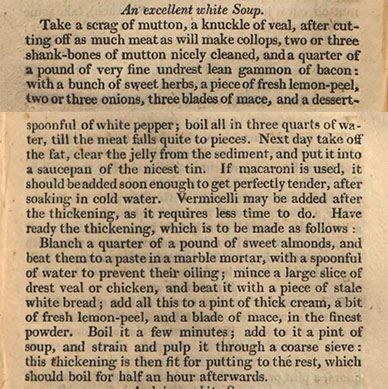As the fashionable elite came to eat dinner later and later in the day, supper became almost obsolete. As Maria Rundell notes in the 1813 edition of A New System of Domestic Cookery, “hot suppers are not much in use where people dine very late.” One exception to this rule was a ball, when late hours and active exercise called for substantial evening fare. In Emma, several of the main characters visit a local inn to assess its ability to host a ball, and much is made of the question of where to serve the supper. In the absence of a suitable room, Mrs. Weston proposes simply having sandwiches, but is adamantly shot down. In the words of the narrator, “A private dance, without sitting down to supper, was pronounced an infamous fraud upon the rights of men and women.”
It was expected that a ball would include supper and that this supper would include soup, ideally white soup. We don’t learn in Emma what type of soup is served at the eventual ball, but when Mr. Bingley’s ball is under discussion in Pride and Prejudice, he tells his Caroline, “as for the ball, it is quite a settled thing; and as soon as Nicholls has made white soup enough, I shall send round my cards.” White soup - with roots in medieval courtly cookery, is a rich and time-consuming dish of veal, cream, and blanched almonds. Mr. Bingley’s casual line gives us a short-hand sketch of his character - he is rich and fashionable enough to serve only the best, but he is also considerate enough not to set a date for the ball until he confirms that his cook has the resources and time to supply that fashionable food. Such consideration is a good trait to look for in a prospective husband and bodes well for Jane's future happiness.
Maria Rundell’s recipe "An excellent white Soup" must be started at least one day before it is served, to allow time for the veal base to be made. Additionally, almonds must be blanched, beaten to a paste with cream, veal and lemon, and then strained, before being added to the base. While not for the faint of heart, it certainly does sound delicious enough to grace Mr. Bingley's (or anyone's) ball.

A New System of Domestic Cookery...(1813 edition) by Maria Eliza Ketelby Rundell. Printed by S. Hamilton for J. Murray. Image combines portions of pages 98-99. Janice Bluestein Longone Culinary Archive.
An excellent white Soup
Take a scrag of mutton, a knuckle of veal, after cutting off as much meat as will make collops, two or three shank-bones of mutton nicely cleaned, and a quarter of a pound of very fine undrest lean gammon of bacon: with a bunch of sweet herbs, a piece of fresh lemon-peel, two or three onions, three blades of mace, and a dessert-spoonful of white pepper; boil all in three quarts of water, till the meat falls quite to pieces. Next day take off the fat, clear the jelly from the sediment, and put it into a saucepan of the nicest tin. If macaroni is used, it should be added soon enough to get perfectly tender, after soaking in cold water. Vermicelli may be added after the thickening, as it requires less time to do. Have ready the thickening, which is to be made as follows:
Blanch a quarter of a pound of sweet almonds, and beat them to a paste in a marble mortar, with a spoonful of water to prevent their oiling; mince a large slice of drest veal or chicken, and beat it with a piece of stale white bread; add all this to a pint of thick cream, a bit of fresh lemon-peel, and a blade of mace, in the finest powder. Boil it a few minutes; add to it a pint of soup, and strain and pulp it through a coarse sieve: this thickening is then fit for putting to the rest, which should boil for half an hour afterwards.
Notes for adventurous cooks:
- A scrag of mutton is a cut of lamb that comes from the neck.
- A knuckle is a hinge joint, such as the knee. These can be difficult to find in many grocery stores, but veal shanks or any bony meat can substitute.
- "Sweet herbs" refers to fresh aromatic herbs. This blog post from Savoring the Past suggests thyme and marjoram as two of the most common inclusions.
Bibliography:
Lane, Maggie. Jane Austen and Food (London: The Hambledon Press, 1995)